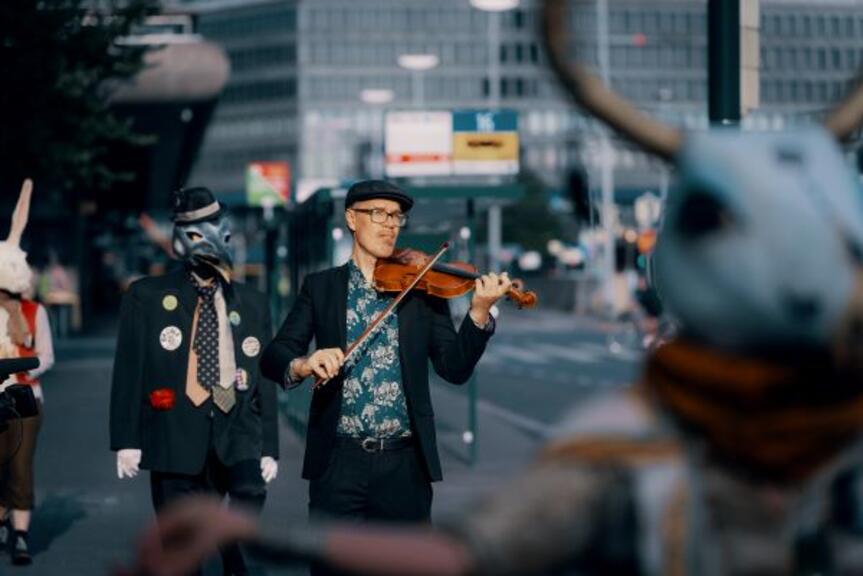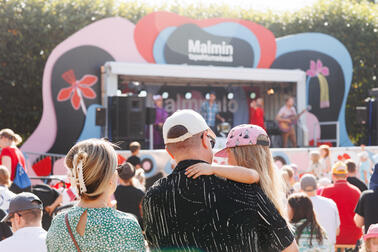
The coronavirus recovery aid granted to the field of culture and leisure activities enabled a record number of events within the cultural offering in Helsinki during the past summer. The varied events also employed a large number of operators in the field of culture who had been suffering from the long-lasting pandemic and the related restrictions. Large numbers of residents and tourists visiting Helsinki had the chance to enjoy the experiences offered in different parts of the city, most of them free of charge.
With the coronavirus recovery aid for culture and leisure activities, the past summer’s events offering both in the city centre and cultural centres was richer and more varied than ever. Events arranged at the Espa Stage, in the yards of cultural centres and on the streets in the city centre drew tens of thousands of residents and tourists. The events at the Espa Stage alone had a total of nearly 100,000 visitors.
Summer yards and the Espa Stage filled with events
More than 300 events in total were arranged in the summer yards of cultural centres and on the Espa Stage during the summer. Traditional Espa Stage events started in mid-May and continued until the first weekend of September. In total, about 130 performers appeared on the Espa Stage during the summer. The audience could enjoy music, dance, circus and stand-up, among other things. The opening on 19 May featured Maria Ylipää and Emma Salokoski, among others. Etno-Espa, a city festival for new Finnish folk music, started on 1 August when the world-famous folk band Värttinä took the stage.
The programme of the summer yard events at cultural centres included music gigs, urban gardening, dancing, open stage nights and theatre. The coronavirus recovery aid was used to produce e.g. the Ala-Malmi Event Park, where art and culture were brought to the city renewal area and made available to all Helsinki residents; the Maunula House Summer Square event series and the Kanneltalo 30th anniversary celebrations in Kannelmäki in August. The events produced with the coronavirus recovery aid during the summer had approximately 480 artists performing.
Living Streets and a tram art event employed more than 100 artists
From June to August, the Helsinki Living Streets event series spread in the centre of Helsinki to the Helsinki Biennial pavilion on the Market Square, the Makasiinipuisto Park in the Töölönlahti area, the summer yard of the National Museum, the Espa Stage and the city’s Summer Streets in front the Design Museum. In addition, the city centre was invigorated by the return to regular daily life, as well as an event organised on 11 August where the surroundings of tram and metro stops and the Helsinki main railway station turned into stages, gig venues and street theatre to the enjoyment of people passing by. The Living Streets and tram art event provided employment to 110 artists.
“The summer programme arranged with the help of the coronavirus recovery aid supported parties working in the field of culture, attracted people once again to cultural services and enlivened the city centre. Through the funding, we make an investment that provides all Helsinki residents and visitors with opportunities to have a good time together with other people, now that the restrictions due to the pandemic have finally been lifted. The wide selection of events also serves as a means for the culture sector to recover following an exceptional period of time”, says Laura Aalto, Culture and Leisure Deputy Executive Director.
Microgrants used to create small-scale events
In addition, €250,000 was granted to creators of art and culture in Helsinki in the form of new microgrants to facilitate recovery after the pandemic. The aid was used to create nearly 300 additional small-scale art and cultural events that were open to everyone free of charge. These events included a gramophone dance on the Baana, a Georgian table song event at Teurastamo, and Ostrobothnian songs and puppet theatre as a travelling bicycle theatre in the Kallio district.
A record number of events and experiences were arranged in the centre of Helsinki during the summer. Picture: Aki Rask.


